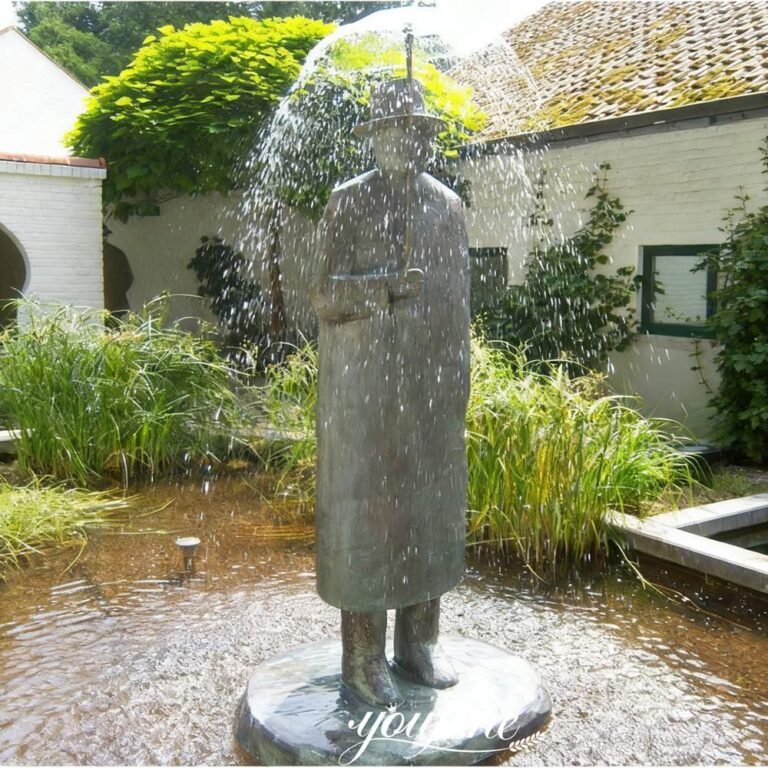Marble fountain is a wonderful landscape feature. Having a marble fountain in your backyard is the perfect way to relax and calm down. However, installing a marble fountain may seem like a challenging task, but with the right guidance, it can be a rewarding and satisfying experience. In this article, you will get a complete guide to the marble installation steps, along with some maintenance measures to make your fountain last longer.

Before installing a fountain, taking some time to do some preparatory work is crucial to make your installation process smoother. Here are some suggestions to inform you in advance before installing:
Firstly, make sure your local government allows you to install a fountain.
In general, small household fountains (such as small fountains within 2m in diameter) will not be regulated by the government. However, fountains in public areas such as gardens and squares need approval, and some large fountains also need government permission before they can be installed. So it is recommended that you find out if there are any formalities required before you plan to buy a fountain.
Secondly, regarding the installation address:
①Ensure that the size of the installation address are appropriate. In general, the size of your installation location should be a portion larger than the outermost size of the fountain(the fountain’s pool).
②Smooth the floor before installation to ensure that your fountain is on a level surface, which will make the fountain last longer.
③Avoid having too much clutter around. For example, the leaves of plants falling into the fountain pool will affect the water circulation of the fountain. If it cannot be avoided, it is necessary to clean the water regularly to ensure the circulation of the fountain.
④The installation address should be from the design point of view, in line with the aesthetic concept, after the installation to make people feel comfortable and beautiful, if possible you can ask the designer to help you locate, we also have experienced designers, can provide you with free installation advice.
Thirdly, about the exterior facilities. Make sure the water and electricity are connected to your fountain smoothly. You should measure the distance in advance and prepare adequate plumbing and other equipment.
Lastly, Tools and materials:
During the installation process, a lot of equipment, tools and materials are needed to ensure a smooth installation. The following is my list of necessary content for you, please prepare in advance.
Tools:
- Shovels and Spades: For excavation and preparation of the site.
- Leveling Tools: Including a builder’s level, laser level, or leveling app for precise measurements.
- Measuring Tape: Essential for marking the dimensions of the fountain’s base.
- Wheel barrow: For transporting materials like gravel, concrete, and tools.
- Trowels: Used for applying mortar or concrete mix.
- Rubber Mallet: To gently tap and secure fountain components in place.
- Screwdrivers and Wrenches: For assembling and securing fountain parts.
- Masonry Tools: Including chisels and masonry hammer for adjusting stone or concrete components.
- Safety Gear: Such as gloves, safety glasses, and work boots to protect yourself during installation.
Materials:
- Concrete Mix: For creating the fountain’s stable base and anchoring components.
- Gravel or Crushed Stone: To create a compacted foundation layer for drainage and stability.
- Mortar Mix: Used for joining and securing the fountain’s components.
- Fountain Components: Including the fountain basin, pedestal, tiers, spouts, and decorative elements, which you can custom by YouFine factory.
- Plumbing Components: Such as pipes, hoses, and a water pump for circulating water.
- Waterproof Sealant: To prevent water leakage and ensure longevity.
- Anchoring Hardware: Bolts, screws, and anchors for securing the fountain components.
- Water Source: Depending on the design, you may need access to a water supply line.
- Electrical Wiring: For fountain lighting or water pump operation.
- Landscape Fabric: To prevent weed growth beneath the fountain.
- Sand or Gravel: For leveling and stabilizing the fountain’s base.
Do the above preparations and then proceed to the formal installation process.
1. Build the foundation of the fountain
Creating a solid foundation is crucial for the stability and longevity of your large marble fountain. Follow these steps to ensure a secure base:
Site Preparation: Begin by marking the outline of the fountain’s base using stakes and string. Clear the area of any debris, vegetation, or obstacles.
Dig the foundation: The general fountain will have its own pool, which means that you only need to lay a shallow foundation, but if it is an open fountain or a large fountain, it is necessary to lay a foundation of 12-40 inches, and the depth of the foundation is determined according to the needs of the fountain. If you want to know how deep the foundation of your fountain should be dug, you can contact YouFine and we will give you the most professional advice.
Adding Gravel: Fill the foundation with a layer of gravel or crushed stone. This layer provides a stable and compacted base for the concrete to rest on. Use a tamper to compact the gravel evenly.
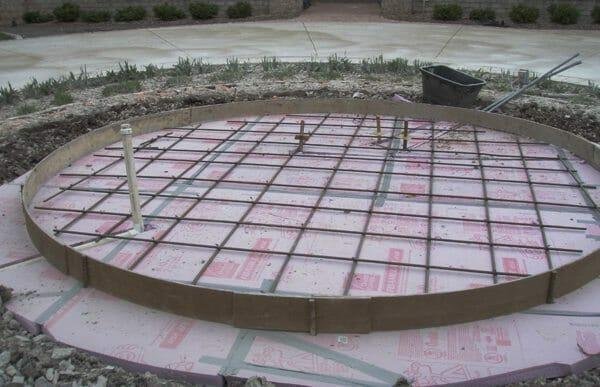
Pouring Concrete: Mix concrete to scale and pour the concrete into the foundation, making sure it covers the entire area and reaches the desired height. Use a trowel to level the surface and ensure an even layer.
Waiting for concrete to cure: It takes 24 hours for the concrete to set completely. For the sake of solidification, we recommend waiting 48 hours before the next step. We had to be very patient to make sure we got a durable and long-lasting foundation.
Waterproofing: Apply a waterproof sealant to the surface of the concrete. This helps prevent water infiltration and ensures the longevity of the foundation.
2. Assemble the fountain
Now that we have a solid foundation, we can begin to assemble the fountain. Assembly follows a bottom-up sequence.
Assembled pedestal: First of all, carefully place the pedestal on the corresponding foundation position according to the serial number and secure it to ensure that your pool does not seep.

Assemble the rest: Assemble the main part of your fountain from the bottom-up, attach any spouts or water distribution elements according to the design. Some large fountains will have many decorative sculptural sections. You should install and attach these sections to your fountain after installing the main body.
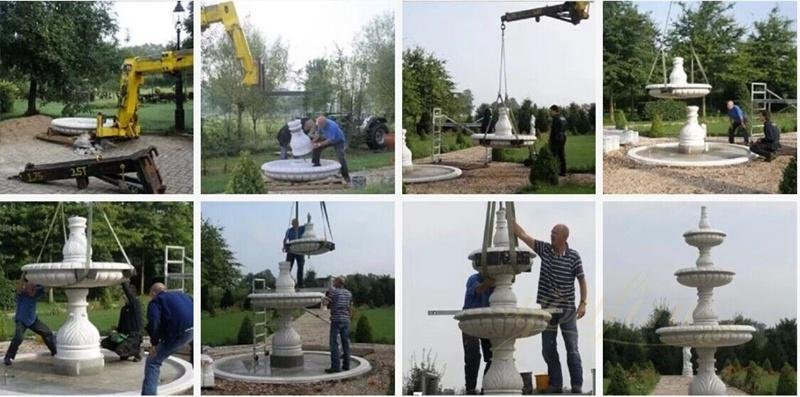
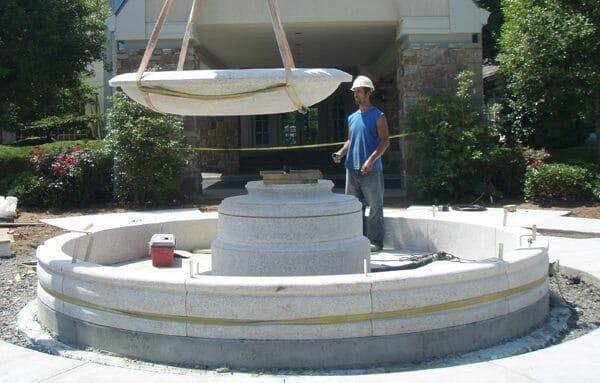
Connect Water Pump and pipes: Every fountain needs a water pump, so you need to follow the manufacturer’s guidelines for installation. Attach the water pump to the appropriate connection point and route the water lines to ensure proper water circulation.
Use PVC piping and fittings to connect the pump to the fountain. Apply plumbers tape and sealant to ensure a watertight connection. Consult the pump’s manual for specific instructions. You can also ask your supplier, You Fine, to help guide the installation steps.
Test the water flow: Fill the fountain basin with water and turn on the pump. Check for any leaks and ensure the water flows smoothly through the fountain tiers.
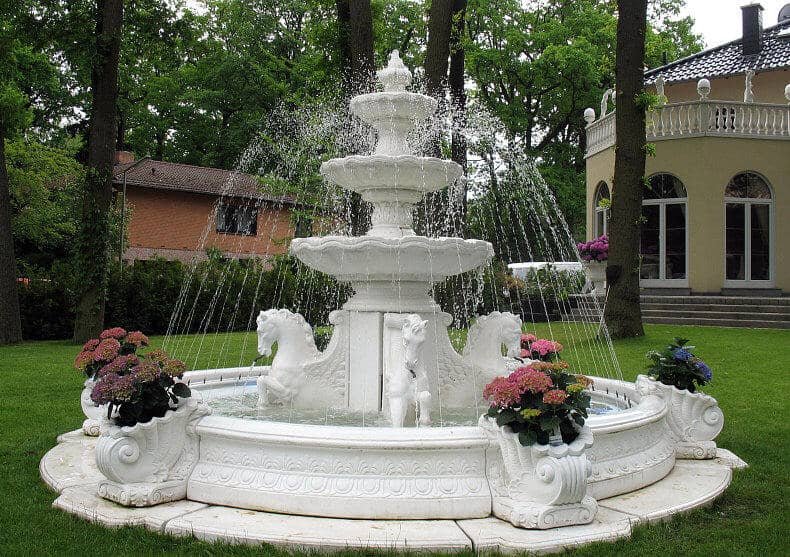
3. Finishing touches
Now that the installation is almost complete, it’s time for some finishing touches
Surface treatment: After confirming that all components are securely attached and aligned, perform a final visual inspection. Wipe down the marble surfaces to remove any dirt or smudges, ensuring the fountain looks its best.
Secure the fountain: Use concrete or construction adhesive to secure the base of the fountain to the concrete foundation. Follow the adhesive manufacturer’s instructions for the best results.
Seal the marble: Apply a waterproofing sealant to the entire surface of the marble fountain. This protects it from weathering, staining, and extends its lifespan. Allow the sealant to dry completely before proceeding.
Check the water level and flow: Ensure the water level in the fountain basin is adequate to keep the pump submerged. Adjust as necessary.
Watch the water flow through the fountain tiers and adjust the pump settings to achieve the desired flow rate. Make any necessary adjustments for optimal water circulation and sound.
Inspect for leaks: Carefully examine all the plumbing connections and fountain components for any signs of leaks. Repair or tighten as needed.
4. Post-maintenance work
Now you have a beautiful marble fountain, but if you want it to last for a long time, you need regular maintenance, here are some of our suggestions for maintenance.
Clean and maintain: Regularly clean the marble fountain with a soft cloth or sponge and a pH-neutral marble cleaner. This helps maintain its luster and prevents the buildup of dirt and grime.
Avoid Stagnant Water: To prevent the growth of algae and other contaminants, regularly replace the water in the fountain. Stagnant water could also lead to mineral deposits on the marble surface.
Drain the Fountain in winter: If it is cold in winter, before freezing temperatures set in, drain the fountain to prevent water from freezing and causing cracks.
YouFine Sculpture offers the best custom marble fountain experience, from design to delivery! We provide a one-stop service for the marble fountain project. Please feel free to contact us if you need any assistance.
Related knowledges:


